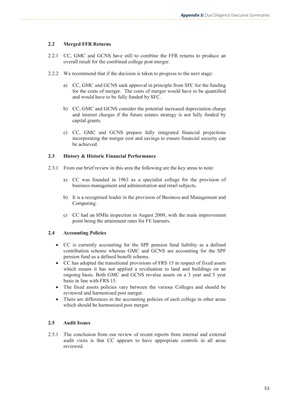
2.2 Merged FFR Returns
2.2.1 CC, GMC and GCNS have still to combine the FFR returns to produce an
overall result for the combined college post merger.
2.2.2 We recommend that if the decision is taken to progress to the next stage:
a) CC, GMC and GCNS seek approval in principle from SFC for the funding
for the costs of merger. The costs of merger would have to be quantified
and would have to be fully funded by SFC.
b) CC, GMC and GCNS consider the potential increased depreciation charge
and interest charges if the future estates strategy is not fully funded by
capital grants.
c) CC, GMC and GCNS prepare fully integrated financial projections
incorporating the merger cost and savings to ensure financial security can
be achieved.
2.3 History & Historic Financial Performance
2.3.1 From our brief review in this area the following are the key areas to note:
a) CC was founded in 1963 as a specialist college for the provision of
business management and administration and retail subjects.
b) It is a recognised leader in the provision of Business and Management and
Computing.
c) CC had an HMIe inspection in August 2009, with the main improvement
point being the attainment rates for FE learners.
2.4 Accounting Policies
� CC is currently accounting for the SPF pension fund liability as a defined
contribution scheme whereas GMC and GCNS are accounting for the SPF
pension fund as a defined benefit scheme.
� CC has adopted the transitional provisions of FRS 15 in respect of fixed assets
which means it has not applied a revaluation to land and buildings on an
ongoing basis. Both GMC and GCNS revalue assets on a 3 year and 5 year
basis in line with FRS 15.
� The fixed assets policies vary between the various Colleges and should be
reviewed and harmonised post merger.
� There are differences in the accounting policies of each college in other areas
which should be harmonised post merger.
2.5 Audit Issues
2.5.1 The conclusion from our review of recent reports from internal and external
audit visits is that CC appears to have appropriate controls in all areas
reviewed.
53
Appendix 5: Due Diligence Executive Summaries